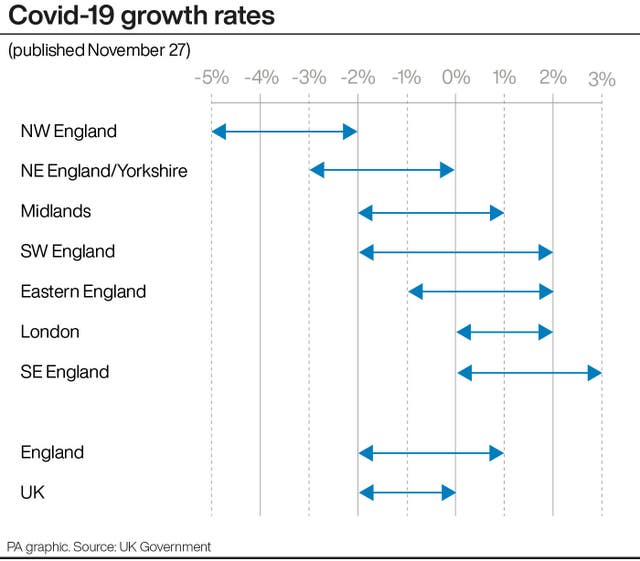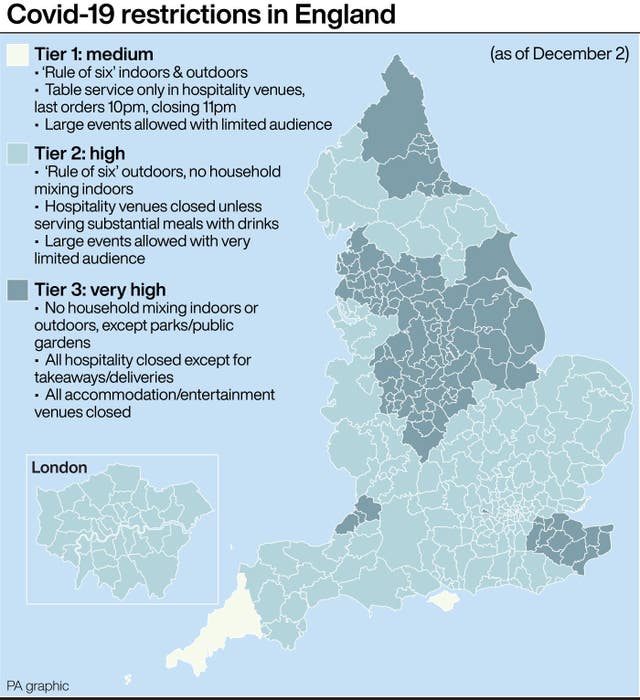Ministers have raised the prospect that some coronavirus restrictions in England could be eased before Christmas as they seek to head off a growing Tory revolt.
Many Conservative MPs reacted with fury after it emerged that 99% of the country is to be placed in the top two tiers of restrictions when the lockdown lifts next week.
There was bafflement that areas with low infection rates are facing tougher controls – including a ban on social mixing indoors – than before they went into lockdown last month.
With a crucial Commons vote looming, Communities Secretary Robert Jenrick insisted there is “every reason” to expect some areas could be moved into a lower tier when the controls come up for their first 14-day review on December 16.
“At that point we – advised by the experts – will look at each local authority area and see whether there is potential to move down the tiers,” he told Sky News.
“There were a number of places which were quite finely balanced judgments where they were on the cusp of different tiers. Those are the places that are more likely to be in that position.”
However, Professor John Edmunds, a member of the Government’s Scientific Advisory Group for Emergencies (Sage) warned there would be limited scope for easing controls so quickly.
“I think that is quite an early time to be able to see what the effect has been. I think we will still be seeing the effect of the lockdown at that point in time,” he told BBC Radio 4’s Today programme.
“I can’t imagine there will be huge changes at that point, just simply because I don’t think we will have accumulated much data by then.”

He said it is important to keep rates down – even in areas of low infection – and that ministers have had to strengthen controls as the previous tiered restrictions had failed to curb the spread of the disease.
“The Tier 1 and Tier 2 really weren’t slowing the epidemic very much at all. We would have just seen those places pick up again quite rapidly,” said Prof Edmunds.
“It is important that we continue to bring the epidemic right down or slow it right down in those low incidence areas as well. If we don’t, the low incidence areas will rapidly become high incidence areas.”
Boris Johnson, visiting the Public Health England laboratory at Porton in Wiltshire, acknowledged the restrictions are “frustrating” – particularly for people in areas of low infection – but said they are necessary to control the disease.
“The difficulty is that if you did it any other way, first of all you’d divide the country up into loads and loads of very complicated sub-divisions – there has got to be some simplicity and clarity in the way we do this,” he said in a pooled clip for broadcasters.
“The second problem is that, alas, our experience is that, when a high incidence area is quite close to a low incidence area, unless you beat the problem in the high incidence area, the low incidence area, I’m afraid, starts to catch up.”
Former cabinet minister Damian Green, Tory MP for Ashford in Kent, which is going into Tier 3, said there is a lot of anger on the Conservative benches.
“I know colleagues in Dorset are very annoyed and our colleagues in Lincolnshire are very annoyed and and quite a lot in other areas where the the incidence is very low,” he told Times Radio.
He said his constituents do not understand why, after successfully driving down infection rates in their area, they now face the toughest controls.
“People here feel obviously everyone has been behaving properly and observing the guidelines and all of that,” he said.
“The reward is we went into the lockdown in Tier 1, we come out in Tier 3, which has just made people think ‘Well, what was the point of this lockdown?’”

Another former minister, Tobias Ellwood, said he would probably abstain in the Commons vote on Tuesday – the day before the lockdown lifts and the new regulations are due to come into force.
The MP for Bournemouth East said his “biggest gripe” is that the decisions on which areas are placed in which tier were based on data that will be more than a week old by the time of the vote.
“I would really like the decisions to be made using up-to-date data a couple of days before these new restrictions come in,” he told BBC Breakfast.
The gathering Tory rebellion could leave Mr Johnson dependent on Labour support if he is to get the measures approved.
Shadow health minister Justin Madders said the party will wait to see the detailed regulations before deciding which way to vote.
He suggested the Government could be forced to make concessions on some of the tiering decisions if it is to get through.
“I think that that’s part of the debate we’re going to have about making sure that the public has got confidence that this is the right thing to do,” he told Times Radio.
As it stands than 55 million people will be placed into Tiers 2 and 3 with only the Isle of Wight, Cornwall and the Isles of Scilly facing the lightest Tier 1 coronavirus restrictions.
Large swathes of the Midlands, North East and North West are in the most restrictive Tier 3, which accounts for 41.5% of the population, or 23.3 million people.




Comments: Our rules
We want our comments to be a lively and valuable part of our community - a place where readers can debate and engage with the most important local issues. The ability to comment on our stories is a privilege, not a right, however, and that privilege may be withdrawn if it is abused or misused.
Please report any comments that break our rules.
Read the rules here